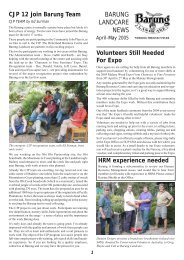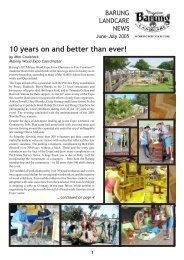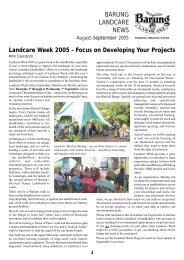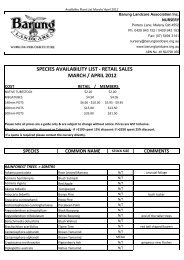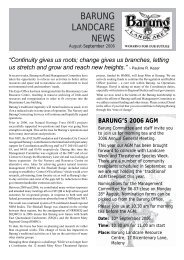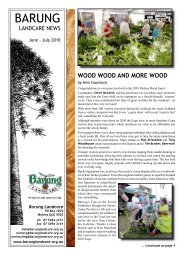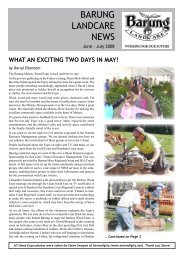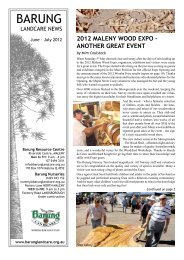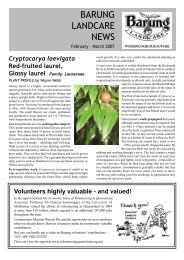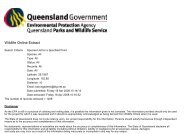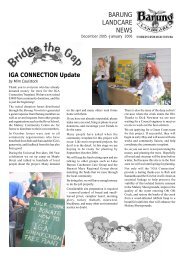Apr/May 2007 - Barung Landcare
Apr/May 2007 - Barung Landcare
Apr/May 2007 - Barung Landcare
Create successful ePaper yourself
Turn your PDF publications into a flip-book with our unique Google optimized e-Paper software.
Irrigation benefits<br />
NURSERY NOTES by Wayne Webb<br />
Firstly, I’d like to say ‘thank you’ to Di<br />
O’Connor who has offered to help out with<br />
the preparation of the plant profiles for the<br />
newsletters. It can take considerable time<br />
researching and assembling the information<br />
required, particularly with frequent interruptions,<br />
so Di has started to draft out profiles on<br />
a range of species that we grow. We hope to<br />
create an information series from these plant<br />
notes, for members and nursery customers to<br />
use as an aid to selecting plants.<br />
For those wondering about the disruptions in<br />
our retail section a while back, we have been<br />
replacing some of the old irrigation system.<br />
Old pipe (which was beginning to split) has<br />
been replaced with higher grade pipe, the<br />
sprinkler layout has been improved, and far<br />
more efficient sprinkler heads have been<br />
installed.<br />
Nursery irrigation performance is measured by a catch-can trail<br />
and looks at three parameters – Mean Application Rate (MAR),<br />
Coefficient of Uniformity (Cu) and Scheduling Coefficient (Sc).<br />
MAR should not exceed the absorption rate of the potting media<br />
used, around 15 mm/hr. Cu is a calculation of how evenly an area<br />
is being watered, with 100% being absolute evenness. Sc is a<br />
measure of how many times longer the area needs to be watered<br />
to ensure the driest spot receives enough, expressed as a number<br />
greater than 1.0, with 1.0 being ideal and 1.2 being acceptable.<br />
As can be seen from the table at the bottom of this page which<br />
shows test results for the old and new systems, the new system is<br />
a considerable improvement and should result in a water saving<br />
of some 56% for this area.<br />
Even water application will also avoid some plants suffering from<br />
being too wet (and associated fungal problems) while others suffer<br />
from drought. A lighter application rate combined with more<br />
even water distribution will also reduce nutrient leaching from<br />
the growing media, resulting in healthier plants, less pollution,<br />
and possible savings in fertilizer.<br />
This upgrade of the irrigation system has been made possible by<br />
a grant from Maleny Credit Union’s Community Trust. To them,<br />
a big ‘thank you’!<br />
Thanks also to our trusty volunteers, Max Smith, Duncan Gregor,<br />
Gordon Halliday and Pat Cavanaugh, who beavered away digging<br />
trenches and spreading fresh gravel to cover up the mess. (Pat<br />
thought he was coming along to help with the newsletter folding<br />
and mail-out!)<br />
Other areas of the nursery irrigation will be upgraded as time and<br />
finances permit.<br />
(Left) Before: the old irrigation system, and ponded/<br />
wasted water due to the high application rate<br />
[Photo by Wayne Webb]<br />
(Above) After: Wayne checks the pressure on the<br />
new irrigation system [Photo by Jane Williamson]<br />
Irrigation efficiency parameter Optimal Old system New system<br />
Mean Application Rate (MAR) 15 mm/hr 37.2 mm/hr 17.3 mm/hr<br />
Cooefficient of Uniformity (Cu) 100% 75.9% 91.1%<br />
Scheduling Coefficient (Sc) 1.0 (1.2 is acceptable) 2.32 1.23



